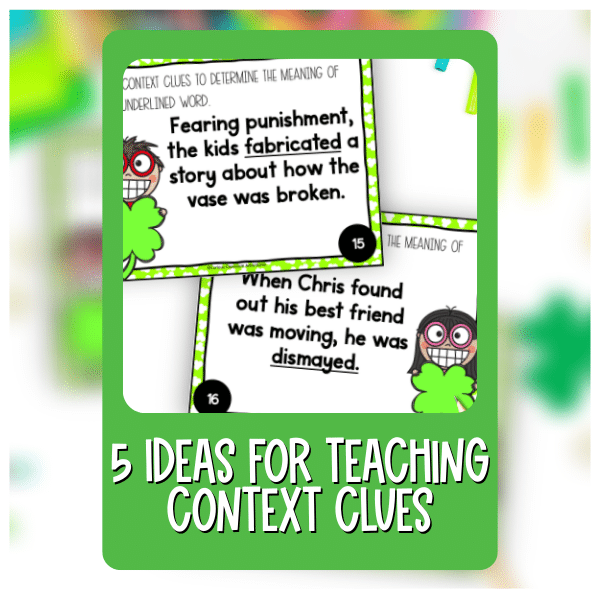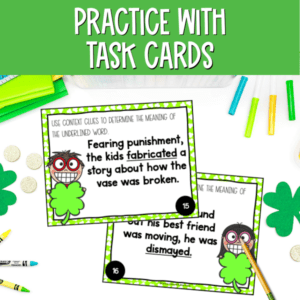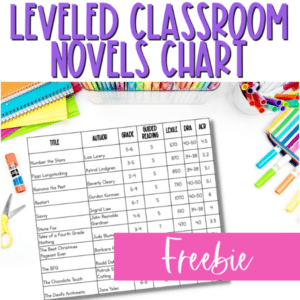Teaching context clues skills to students to help them unlock the meaning of unfamiliar words is a powerful lesson for upper elementary students and one they will put to great use during independent reading (not to mention acing their standardized testing). In this blog post, we’ll explore effective strategies for teaching context clues that language arts teachers can use to help their students become skilled word detectives.
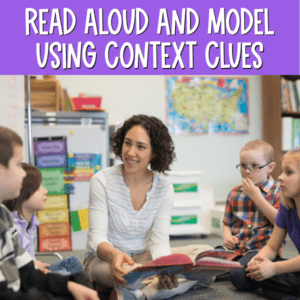
Read Aloud and Model Using Context Clues:
One effective way to help students understand how to use context clues is to model the skill by reading aloud and thinking aloud as you encounter unfamiliar words. This helps students see the thinking process in action and allows them to practice using context clues in a low-stakes environment. After modeling a few examples, have students work in pairs or small groups to practice using context clues as they read aloud to each other.
Teaching Context Clues with Task Cards:
One of the most direct ways of teaching context clues skills is to practice, practice practice. Using context clues task cards is a great way to do that. These handy task cards provide students with isolated sentences that contain an unfamiliar word plust they come is a variety of holiday themes so you’re sure to find the perfect set no matter what time of year you’re teaching context clues. Students read the underlined word and then use the surrounding context of the sentence to deduce the word’s meaning. This focused practice allows them to build confidence and competence so that they can do the same in their everyday reading.
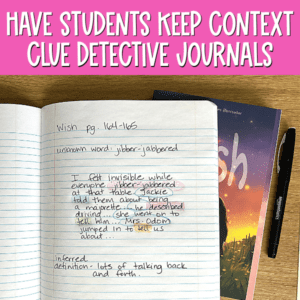
Teaching Context Clues thru Journaling:
Another strategy for teaching context clues is to encourage students to keep a record when reading texts with unfamiliar words. As they encounter unknown terms, they can use a journal or notebook to record the sentence it’s in and the words or phrases around it that offer clues to its meaning by highlighting and adding color to meaningful words. This visual aid reinforces the connection between context and word understanding.

Synonym and Antonym Connections:
So often, the context clues that help students figure out the meaning of a word are also synonyms or antonyms of the unknown word. So one strategy for teaching context clues is to practice and play with synonyms and antonyms to help students build a large vocabulary from which to draw while they are trying to decipher new words based on context.

Predict and Confirm:
Have students read passages containing unfamiliar words and make predictions about their meaning based on context. Afterward, they can read on to confirm their prediction by using dictionary resources to confirm their conclusions.
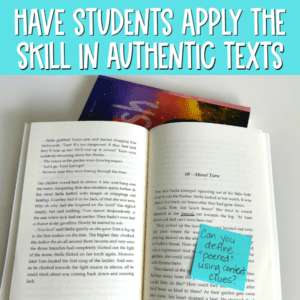
Use Authentic Texts to Apply the Strategy:
Once students have a solid understanding of context clues, start using authentic texts to assess their real-world application of reading strategies. Use passages from novels, newspapers, articles, and other printed materials to help students practice identifying context clues. If you’re looking for some great texts to introduce to your students your sure to find one in this great list of novels perfect for 3rd thru 5th graders.
Teaching context clues strategies to students is an invaluable skill that empowers them as independent readers. Incorporating strategies like context clues task cards, journaling, synonym-antonym exploration, prediction and confirmation, and real-life context application you’re providing your upper elementary students with a rich toolkit for word comprehension. As they become adept at deciphering unfamiliar terms, they’ll approach their reading with confidence and curiosity. Happy word hunting!

